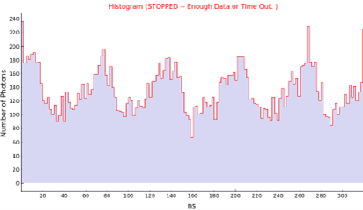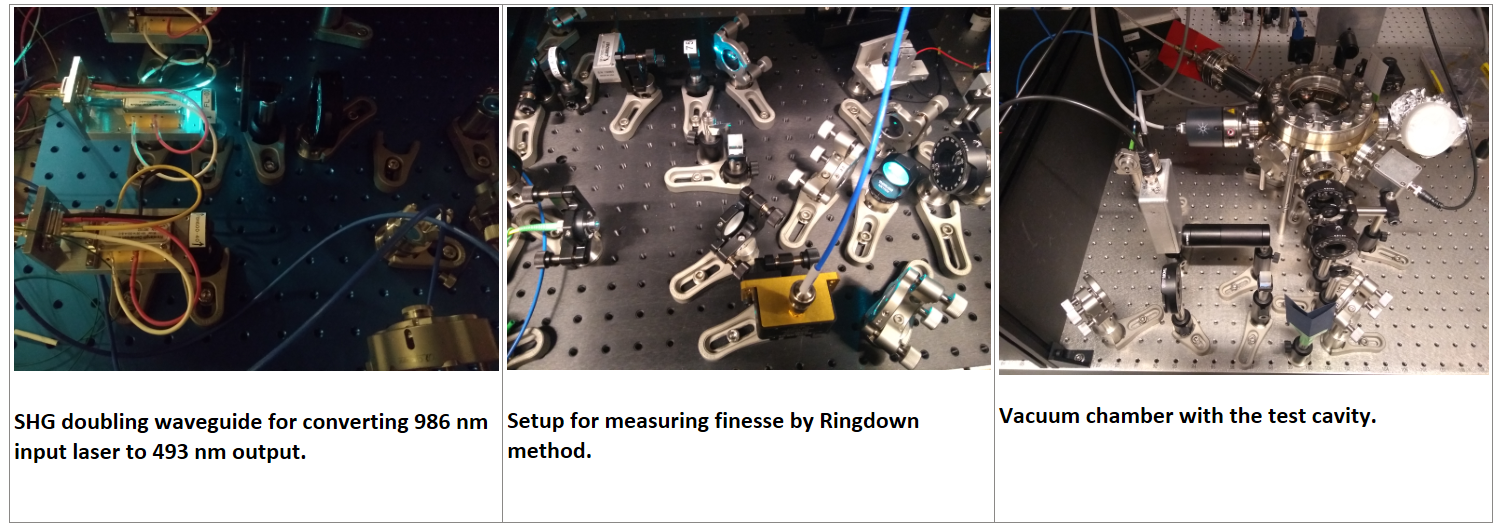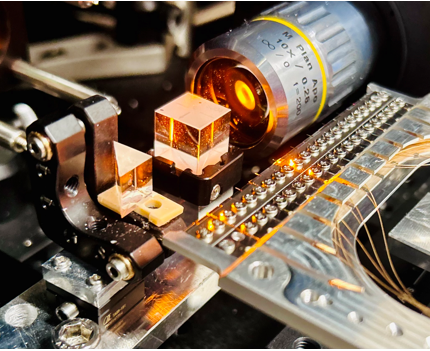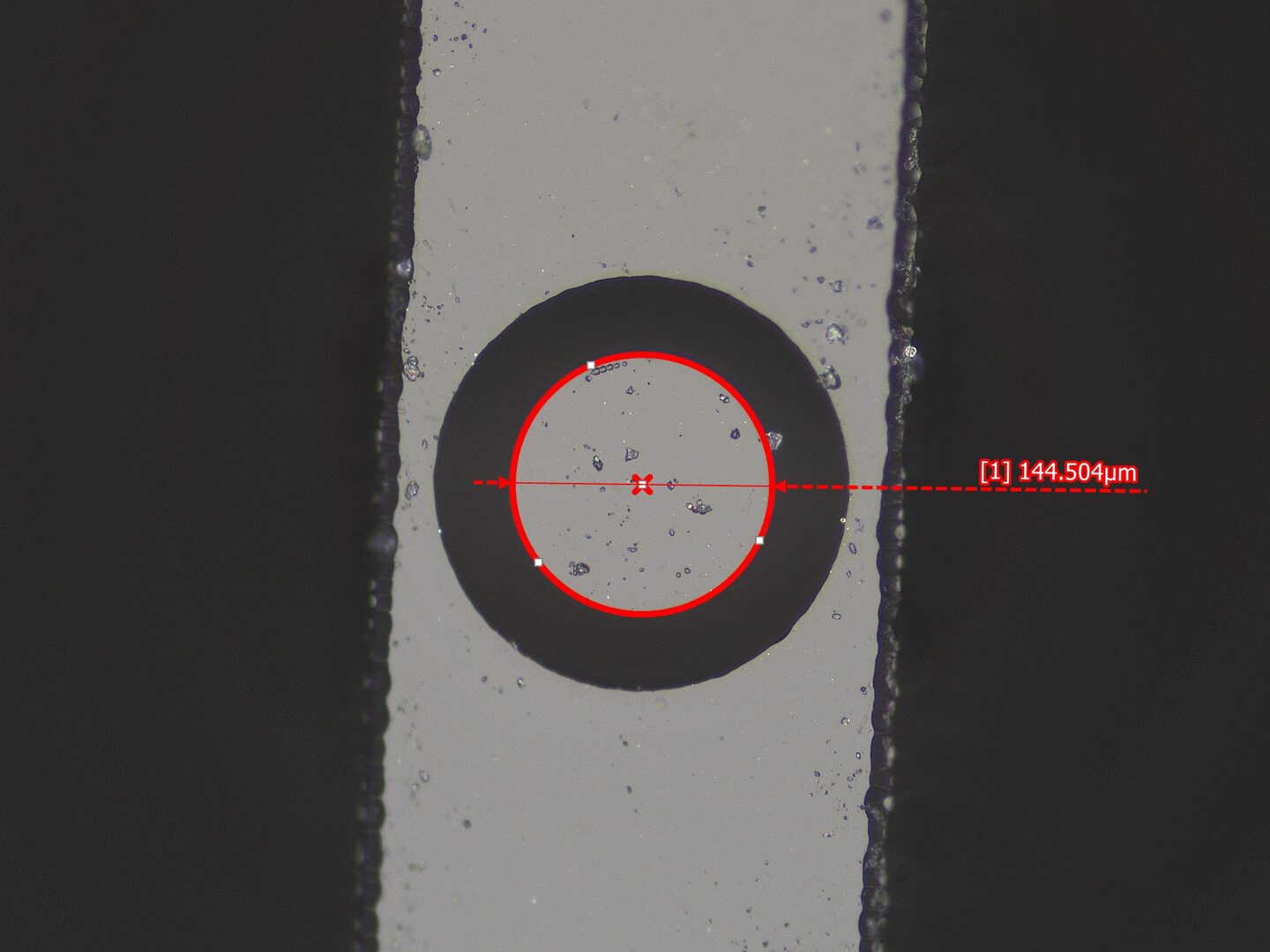FY2023 Annual Report
Experimental Quantum Information Physics Unit
Assistant Professor Hiroki Takahashi

Abstract
The EQuIP have made steady progress in the lab. After successful trapping of ions in the last year, the Ca+ project moved on to investigate physical properties of trapped ions. Despite the setback in the vacuum system, we managed to minimize excess micromotion, measure fluorescence spectra and characterize secular frequencies. In the fiber ablation, a new shooting algorithm was established to machine a concave profile on a fiber facet with a desired shape and symmetry. As a result, we produced dozens of fiber mirrors furnished with high reflective coatings and ready to be used in an ion trap. Another highlight came in the collaboration with the STG Kubo group. A newly designed microwave cavity with large optical apertures was measured at a cryogenic temperature to have a Q-factor exceeding \(2\times10^4\). Using this cavity, electron spin resonance in DPPH and diamond samples was measured to reveal strong coupling of spin ensembles to the cavity.
1. Members
PI
Hiroki Takahashi
Staff Scientist
Ezra Kassa
Postdoctoral Scholars
Diptaranjan Das
Shaobo Gao
Vishnu Kavungal
Research Unit Technicians
Seigen Nakasone
Shigeo Sugitani (retired in Sep. 2023)
Tatsuya Yamazaki
Tomoya Irimatsugawa
Graduate Students
Mathieu Couillard
Morihiro Ohta
Shin Sun
Shuma Oya
Soon Teh
Tatsuki Hamamoto
Zhenghan Yuan
Research Interns
Chitose Maruko
Hikari Kikuchi
Hoi Yan Ian Heung
Saimur Rahman
Artem Podlesnyy
Nikolaos Kokkinidis
Renze Theodor Suters
Shingo Ishimori
Research Assistant
Rion Kamimura
Unit Administrators
Ayano Sakiyama
Kei Goto
2. Collaborations
2.1 Fabrication of low-loss, high-reflection mirrors for ion-trap quantum computers using a transparent conductive oxide thin films
- Type of collaboration: Joint research
- Researchers:
- Prof. Mutsumi Sugiyama (Tokyo University of Science)
- Dr. Tatsuya Yamazaki (OIST)
- Prof. Hiroki Takahashi (OIST)
2.2 Enhancing Quantum Key Distribution with Entanglement Distillation and Classical Advantage Distillation
- Type of collaboration: Joint research
- Researchers:
- Dr. Kenneth Goodenough (University of Massachusetts Amherst)
- Prof. David Elkouss (OIST)
- Shin Sun (OIST)
2.3 EIT photon number resolving
- Type of collaboration: Joint research
- Researchers:
- Prof. Jason Twamley (Quantum Machines Unit, OIST)
- Dr. Kani Mohamed (Quantum Machines Unit, OIST)
- Dr. Anil Kumar (Quantum Machines Unit, OIST)
- Shin Sun (OIST)
- Zhenghan Yuan (OIST)
2.4 Ion trap and cavity integration design
- Type of collaboration: Joint research
- Researchers:
- Prof. Ferdinant Schmidt-Kaler (Universiy of Mainz)
- Dr. Bjoern Lekitsch (Universiy of Mainz)
- Dr. Ezra Kassa (OIST)
- Prof. Hiroki Takahashi (OIST)
2.5 Cavity optomechanics with levitated mirrors
- Type of collaboration: Joint research
- Researchers:
- Prof. Jason Twamley (Quantum Machines Unit, OIST)
- Dr. Jinjin Du (Quantum Machines Unit, OIST)
- Alexander Henry Hodges (Quantum Machines Unit, OIST)
- Shuma Oya (OIST)
2.6 Developing the spin ensemble-based quantum transducer
- Type of collaboration: Joint research
- Researchers:
- Dr. Yuimaru Kubo (Hybrid Quantum Device Team, OIST)
- Dr. Amit Bhunia (Hybrid Quantum Device Team, OIST)
- Tatsuki Hamamoto (OIST)
- Prof. Hiroki Takahashi (OIST)
2.7 Development of Diamond Spin Maser Amplifier
- Type of collaboration: Joint research
- Researchers:
- Dr. Yuimaru Kubo (Hybrid Quantum Device Team, OIST)
- Dr. Ching Ping Lee (Hybrid Quantum Device Team, OIST)
- Dr. Isaac Quijandría Díaz (Quantum Machines Unit, OIST)
- Dr. Mohamed Hatifi (Quantum Machines Unit, OIST)
- Prof. Jason Twamley (Quantum Machines Unit, OIST)
- Prof. Hiroki Takahashi (OIST)
3. Activities and Findings
WG1 (Calcium ion trap)
Following the successful trapping of ions, the goal in FY2023 was to characterise the trap: measure secular frequencies as a function of trap voltages and study the ion's response nearby dielectrics. The project encountered several technical setbacks: (a) the ion gauge failed (forcing us to rely on the less accurate ion pump pressure readings); (b) one of the SMARACT translation stage sets stopped functioning and cannot be moved by the remote controls (preventing us from retracting one of the pyramids); (c) the chamber pressure rose (and keeps rising) indicating a (virtual) leak or a degradation of the ion pump and/or titanium sublimation pump; this has limited the ion lifetime to below 5 minutes on average. The lifetime and count rate were improved by replacing the 397 nm diode laser with a second harmonic generation source significantly reducing the shelving rate of the ion to a dark state.
An rf-correlated photon count measurement setup was established and used to characterise micromotion. Compensation of excess micromotion is now automated. Axial secular frequency measurements indicated that there's an additional axial confinement other than the endcap DC confinement of circa 200 kHz which remains unindentified. We have ruled out rf axial confinement by checking for correlations of this offset with the rf amplitude. This finding concurs with simulation results.

WG2 (Barium ion trap)
The goal of WG2 is to implement a cavity Quantum Electrodynamics (cQED) experiment using Barium ions. With Barium ion’s strong S-P dipole transition at 493 nm, we can expect a much stronger light-matter coupling in a Cavity Quantum Electrodynamics (cQED) system than what we can have with Calcium ions (which are currently being used in our other experiments). This high coupling can be exploited for exploring fast light-atom entanglement generation and coupling in the dispersive regime. However, to date, there have been no cQED experiments with Barium ions. Towards this goal, we are testing Highly Reflective mirrors (LaserOptik HR493), in vacuum. Earlier works have shown degradation of mirror coating by UV irradiation in vacuum leading to poor performance of optical cavities built by the mirrors. However, this has not been established for the wavelength of our interest, 493 nm.
To test for possible degradation a Fabry-Perot cavity was built with the Highly Reflective mirrors and placed in vacuum at 10-8 mBar. We are testing degradation by two different mechanisms that are known from previous studies. The first type takes place by oxygen diffusion in vacuum over time. We have observed no such degradation over the past year.
The second type involves binding of outgassing hydrocarbons to the oxygen on mirror surface under continuous exposure to UV light. Though we have not observed any degradation by this mechanism so far, we have not yet had a prolonged exposure to 493 nm light at high powers. To do so, we locked the laser to the cavity to the laser at 493 nm. For this, we used a new laser (Toptica TA pro at 986 nm) doubled by NTT SHG waveguide. This resolved issues with laser current noise at high frequencies as well as line noise (60 Hz) that had made it difficult to lock the cavity. With a continuous exposure to 493 nm laser, we noticed that the cavity started showing signs of degradation at a rates that depend on the intracavity power.

Though we observe a higher decay rate at high powers, we do not find a clear relation between intracavity powers and cavity loss rate. This is still under investigation. Slow recovery was observed on exposure to atmospheric Oxygen. The recovery was accelerated by exposure of the affected area to 397 nm laser.
WG3 (Fibre Ablation)
WG3 aims at fabricating micro mirrors on optical fibre tips with high quality and stability. We successfully developed a CO2 ablation algorithm to shoot many batches of concave fibre mirrors with success rate close to 100%. The specification of these mirrors are, Diameter>60um, Radius of Curvature from 200-800 um, surface roughness <0.2nm, ellipticity (eccentricity)<0.2. These results are achieved by redesigning the hardware and the software. On the hardware side, the system can switch between "ablating configuration", "imaging configuration", and "surface reconstruction configuration" in-progress, without moving the fibre. On the software side, we introduce active feedback dot shooting algorithm which corrects the mirror ablation profile based on each iteration. With these improvements, we can reliably produce fibre-based micro-cavities to be integrated with an ion trap, which is the key technology for the photon mediated trapped ion quantum computing.


Proof of Concept (POC) Project
The POC program is a funding program designed to help bridge the gap between lab discoveries and commercialization. Under this program, we are developing 3 types of products based on findings from our research activities. (1) Following the first-generation monolithic ion trap that we produced using the Selective Laser Etching technique, we are developing a more compact ion trap with larger optical access and which can be integrated with miniature optical cavities without losing its ability to maintain a stable chain of ion. (2) We have made miniature optical cavities from UV fused silica glass samples also using the Selective Laser Etching technique. These cavities can be integrated with an ion trap; they offer good stability which is essential for ion-cavity coupling. We are now characterising the reflectivity and the losses of these mirrors. (3) We have developed the first prototype of a tunable fibre coupled acousto optic modulator and are now in the process of improving the bandwidth of the device.

4. Publications
4.1 Journals
- S.Sun, L.-C.Shih, Y.-C.Cheng, Efficient quantum simulation of open quantum system dynamics on noisy quantum computers, Physica Scripta, doi: 10.1088/1402-4896/ad1c27 (2024).
- T. Hamamoto, A. Bhunia, R. K. Bhattacharya, H. Takahashi, Y. Kubo, Dielectric microwave resonator with large optical apertures for spin-based quantum devices, arXiv:2403.08458 (2024).
- K. Tanji, H. Takahashi, W. Roga, M. Takeoka, Rate-fidelity trade-off in cavity-based remote entanglement generation, arXiv:2403.15179 (2024).
4.2 Books and other one-time publications
- [解説] H.Takahashi, A.Noguchi, イオントラップを用いた量子コンピュータ、日本物理学会誌78, 8 (2023).
- Scaling up trapped-ion quantum computers, Nature, Focal Point on Quantum computing in Japan, ISSN 1476-4687 (online), ISSN 0028-0836 (print), Feb. 28 (2024).
4.3 Oral and Poster Presentations
Invited Talks
- H.Takahashi, イオントラップ量子コンピュータ, 映像メディア学会年次大会, Online, Aug. 30 - Sep. 1 (2023).
- H.Takahashi, Quantum Photonic Interconnects between Ion Traps, 78th Annual Meeting, The Physical Society of Japan, Tohoku University, Sep. 16 - 19 (2023).
- S. Gao, S. Teh, E. Kassa, H. Takahashi, Monolithic Ion Trap Integrated with a Micro-Optical Cavity for Quantum Networks, 28th Microoptics Conference (2023).
- H.Takahashi, Towards photonics interconnects between ion trap quantum computers, MNC2023, Sapporo, Japan (2023).
- H.Takahashi, Towards integration of a miniature optical cavity in a linear ion trap, Feedback in Quantum Machines, OIST (2023).
- E.Kassa, On the Integration of miniature optical cavities with a linear ion trap, QIT49 conference, Dec. 18 (2023).
Contributed Talks
- E. Kassa, S. Teh, S. Gao, H. Takahashi, Fabrication and evaluation of a monolithic 3D linear ion trap for the integration of an optical cavity, 78th Annual Meeting, The Physical Society of Japan, Tohoku University, Sep. 16 - 19 (2023).
- M. Ohta, C. P. Lee, H. Takahashi, Y. Kobo, Electron Spin Resonance of Neutral NV centers in diamond at millikelvin temperature, 78th Annual Meeting, The Physical Society of Japan, Tohoku University, Sep. 16 - 19 (2023).
- Tatsuki Hamamoto, Amit Bhunia, Rupak Kumar Bhattacharya, Hiroki Takahashi, Yuimaru Kubo, Developing a Microwave-Optical Resonator at Cryogenic Temperatures, 78th Annual Meeting, The Physical Society of Japan, Tohoku University, Sep. 16 - 19 (2023).
- H.Takahashi, Fiber Fabry-Perot Cavities for EMO Transduction, The 5th Qfilter workshop, OIST, Nov. (2023).
- T. Hamamoto, A. Bhunia, R. K. Bhattacharya, H. Takahashi, Y. Kubo, Developing a Hybrid Cavity at Cryogenic Temperatures towards a Quantum Transducer with Color Centers in Diamond, Spins in Lyon, Lyon, France, Dec. 4 - 5 (2023).
- M. Ohta, C. P. Lee, H. Takahashi, Y. Kobo, Electron Spin Resonance of Neutral NV centers in diamond at millikelvin temperature, Spins in Lyon, Lyon, France, France, Dec. 4 - 5 (2023).
Posters
- S. Teh, E. Kassa, S. Gao, H. Takahashi, Monolithic Miniature 3D Linear Trap for Cavity Integration, Seventh European Conference on Trapped Ions (ECTI) 2023, Bückeburg, Germany, Sep. 25 - 29, (2023).
- D. Das, E. Kassa, H. Takahashi, Towards cavity quantum electrodynamics with Barium ions, Seventh European Conference on Trapped Ions (ECTI) 2023, Bückeburg, Germany, Sep. 25 - 29, (2023).
- T.Hamamoto, Developing a Hybrid Cavity at Cryogenic Temperatures and Achieving a Strong Coupling in the Microwave Cavity, Feedback in Quantum Machines 2023, Okinawa, Japan, Nov. 26 - Dec. 2 (2023).
- S.Sun, K.Goodenough, D.Elkouss, Enhancing Quantum Key Distribution with Entanglement Distillation and Classical Advantage Distillation, Quantum Information Processing 2024, Taipei, Taiwan, Jan. 13 - 19 (2024).
- S. Teh, E. Kassa, S. Gao, H. Takahashi, Monolithic Miniature 3D Linear Trap for Cavity Integration, NTT x OIST Joint Workshop, Feb. (2024).
- S. Oya, S. Teh, E. Kassa, S. Gao, V. Kavungal, H. Takahashi, Integration of a fiber cavity with a miniature linear ion trap, ムーンショット目標6公開シンポジウム, Tokyo, March 27-28 (2024).
Seminars
- E.Kassa, On the integration of miniature optical cavities with linear ion traps, NIST + NICT seminar series, Online, May 23 2023.
Symposium
- H.Takahashi, Fault-tolerant Quantum Computing with Photonically Interconnected Ion Traps, Moonshot International Symposium, Akasaka, Tokyo, Jul. 19 (2023).
- H.Takahashi, Towards photonic interconnects between ion traps, Japan-Denmark Symposium on Practical Quantum Computing, Tokyo, Feb. 13 (2024).
- H.Takahashi, イオントラップによる光接続型誤り耐性量子コンピュータ, ムーンショット目標6公開シンポジウム, Tokyo, Mar. 27 (2024).
5. Intellectual Property Rights and Other Specific Achievements
Nothing to report.
6. Meetings and Events
Seminar
Title: Controlling Ions in a Two-Dimensional Array
Date: Nov. 20, 2023
Venue: Lab4, level E, L4E48
Speaker: Dr. Nathan Lysne, National Institute of Standards and Technology (NIST)
7. Other
7.1 External Fund
- JST Moonshot R&D (Grant Number JPMJMS2063).
"Fault-tolerant Quantum Computing with Photonically Interconnected Ion Traps"
- JST CREST (Grant Number JPMJCR1873).
"Manipulation of an optomechanically coupled oscillator using a quantum filter"
- MEXT Quantum Leap Flagship Program (MEXT Q-LEAP) Grant Number JPMXS0118067477.
7.2 Outreach
- Ezra kassa - POC (OIST Innovation) project: presentations to industry and venture capitals.
- Shaobo Gao - Assistance of KEIO medical school summer camp
- Soon Teh - Research Planning Seminar at Kyushu University
- Tatsuki Hamamoto
- Morihiro Ohta
7.3 Visitors
- Dr. Nathan Lysne, National Institute of Standards and Technology (NIST), 20 Nov. 2023.
- Mr. Noriaki Horiuchi, Nature Photonics, 14 Mar. 2024
- Mitsui & Co., Ltd., 11 Apr. 2024.



